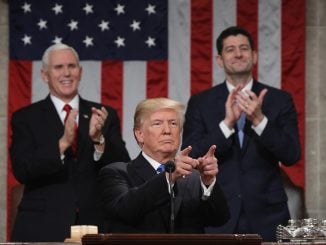RALEIGH — Since winning the White House in 2016, President Trump has called on Congress to pass a major infrastructure package aimed at improving the nation’s roads, ports, bridges and railway system. While negotiations to pass such a bill have repeatedly faltered, the effort has taken on new urgency as lawmakers point to it as a way to help the economy at least partially recover from the current coronavirus-induced recession.
America’s 64-year old Interstate Highway System dates all the way back to President Dwight D. Eisenhower, whose administration first authorized its construction under the Federal Aid Highway Act of 1956. The system extends throughout the U.S. including routes in Hawaii, Alaska, and Puerto Rico. Though the federal government funds some road construction, interstate highways are owned and maintained by the states in which they operate.
The Washington Post recently reported that transportation departments across the nation face a projected $50 billion shortfall due to a drop in gas tax revenue. While traffic has rebounded on the nation’s roads in recent weeks, it is still far below normal levels, and the prospect of continued disruption is making experts question just how viable a motor fuels tax is as a primary funding mechanism.
Specifically calling attention to North Carolina’s transportation challenges, the report focused on the recent situation caused by a legal provision recently triggered by low cash reserves at the North Carolina Department of Transportation (NCDOT). The shortfall prevented the department from entering into any new contracts. The Post noted that more than 100 projects had been delayed by the state even before the pandemic occurred.
As such the NC Chamber is calling attention to a new study released by TRIP, a national transportation nonprofit, identifying just how dismal the state’s aging infrastructure has become. The report, titled Restoring the Interstate Highway System: Meeting America’s Transportation Needs with a Reliable, Safe & Well-Maintained National Highway Network, finds that our interstates saw the third-highest increase in vehicle miles traveled between 2000 and 2018 and that NC has the 18th-highest share (3%) of interstate bridges rated in poor or structurally deficient condition. Additionally, 21 percent of the state’s interstate bridges were found in need of repair or replacement.
“In North Carolina, it is no secret that we have had our challenges keeping our transportation funding up to speed with our growing population,” says NC Chamber Director of Government Affairs Mark Coggins. “Rising costs from historic storms, an inadequate revenue stream, and the COVID-19 pandemic have all combined to create a virtual transportation crisis here in North Carolina.”
Another factor making things worse is that even in light of the pandemic, North Carolina’s population continues to rise, as people move out of crowded metropolitan cities in favor of our state’s great quality of life and comparatively lower cost of living. As such, Coggins points out that North Carolina maintains the second most miles traveled next to Texas.
“The growth in traffic on our interstates and the mediocre conditions of our roads and bridges revealed in this report highlight just how dire that crisis has become. Our state, its businesses, and its people all rely on transportation to succeed. The TRIP report makes it clear that our state’s leaders must act to modernize our revenue stream and encourage federal leaders to make the infrastructure investments our nation needs to secure a prosperous future.”
According to the Chamber, over the next decade the NCDOT will only have funds available for 17% of the state’s needed projects. During that same time frame, the group estimates 57% of the revenue currently used to fund infrastructure projects will decline due what they cite as an over reliance on the dwindling motor fuels tax.
The legislature has taken some steps to address the state’s aging infrastructure, such as recently passing House Bill 77 which put additional money towards the state’s “Build NC” bond package and added roughly $100 Million for the state to conduct road maintenance and general repairs. Still, the Chamber points out there is a $1.5 billion hole in the NCDOT right now and that weekly travel is down 50% due to coronavirus-related travel restrictions.
“We at the Chamber appreciate the legislature’s efforts but still don’t feel it is enough to get us to where we need to be as a state,” Coggins says. “The larger question remains: how can we ensure North Carolina creates a sustainable and diversified revenue stream that keep our roads, railways, ports, and airports well-funded not just next year but over the next decade and beyond?”
In response, the Chamber has organized a coalition of businesses to address some of the problems related to funding infrastructure projects well into the future. They are calling the initiative, Destination 2030: The Road to a Stronger Transportation Future, which will as Coggins puts it work with its partners to push for a more modernized transportation revenue model.
“As our connection to the global economy increases, North Carolina’s transportation infrastructure networks are integral components of our state’s competitive future. The NC Chamber is committed to building upon the state’s available infrastructure investments and advocating for solutions to diversify its revenue streams to finance critical transportation infrastructure projects that will improve our roads, railways, ports, water and sewer systems, energy resources and broadband availability,” Coggins says.
The NC Chamber Foundation is also part of the effort. Later this summer, the Foundation, in partnership with NC State’s Institute for Transportation Research and Education (ITRE), will release the results of a new study to identify the four most workable long-term transportation funding options for the state. While Coggins did not comment on specifics he says potential sources of current revenue include money collected from the gas tax, the highway use tax, and fees collected on things associated with travel such as new drivers’ licenses and such.


